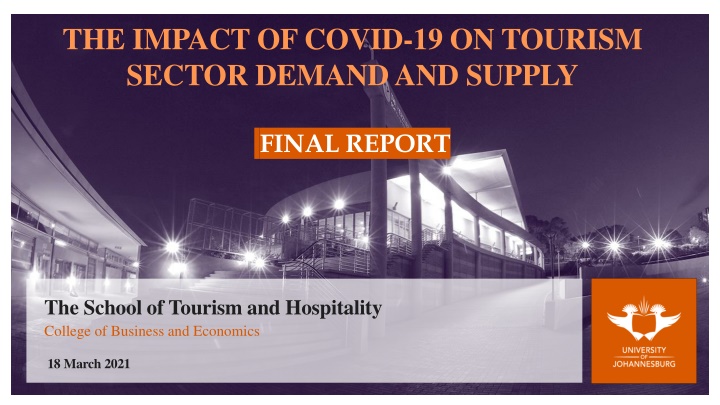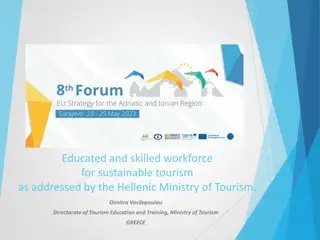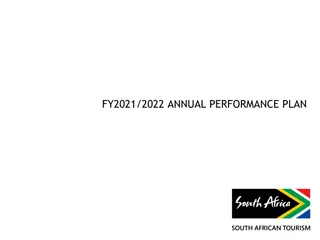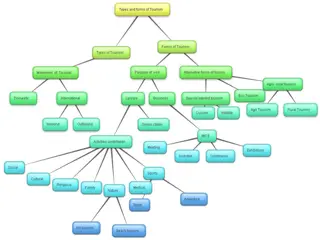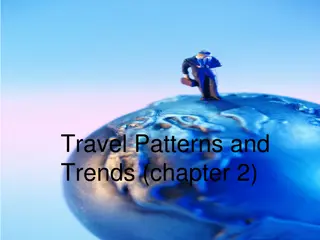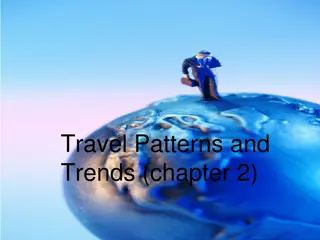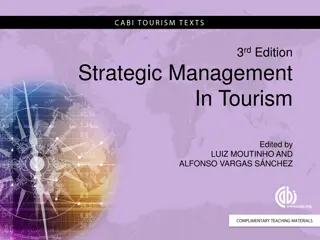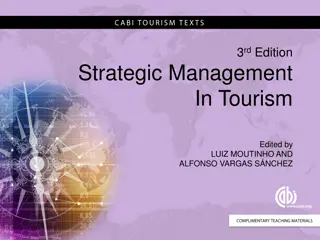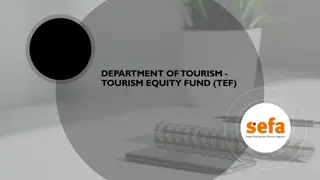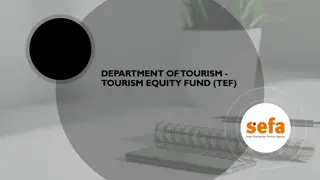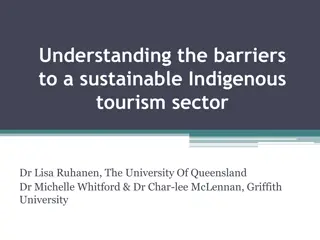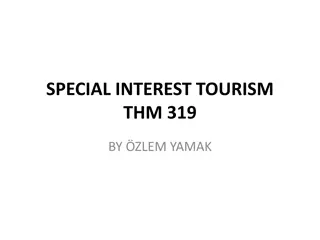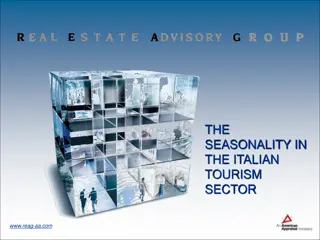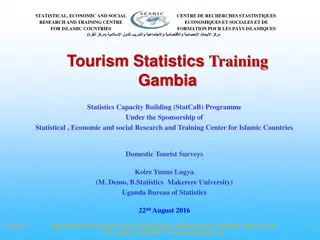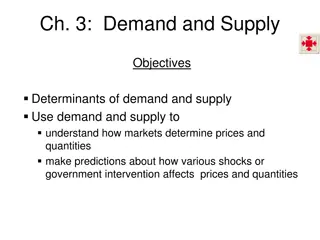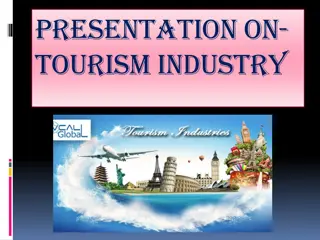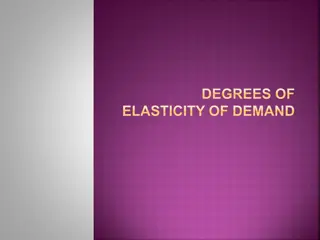The Impact of COVID-19 on Tourism Sector: Demand and Supply Analysis
The study assesses the impact of COVID-19 on tourism products' demand and supply, proposing interventions for post-pandemic tourism recovery. It delves into differing perspectives on the pandemic's irreversible effects, pivotal for reshaping the future of tourism. Objectives include conducting a literature scan, identifying case study localities in South Africa, and analyzing challenges and opportunities post-COVID-19.
Download Presentation

Please find below an Image/Link to download the presentation.
The content on the website is provided AS IS for your information and personal use only. It may not be sold, licensed, or shared on other websites without obtaining consent from the author.If you encounter any issues during the download, it is possible that the publisher has removed the file from their server.
You are allowed to download the files provided on this website for personal or commercial use, subject to the condition that they are used lawfully. All files are the property of their respective owners.
The content on the website is provided AS IS for your information and personal use only. It may not be sold, licensed, or shared on other websites without obtaining consent from the author.
E N D
Presentation Transcript
THE IMPACT OF COVID-19 ON TOURISM SECTOR DEMAND AND SUPPLY FINAL REPORT The School of Tourism and Hospitality College of Business and Economics 18 March 2021
The year 2020 will be forever linked to and defined by the COVID-19 pandemic. As emphasized by Gossling et al. (2020) COVID-19 worldwide spread is not only causing a global crisis for hospitality and tourism but also is dramatically changing consumers wants and market demands that were satisfied by existing tourism value chains and business models during the pre-COVID-19 era. Introduction 3
Two differing narratives or schools of thought are emerging in contemporary tourism debates about COVID- 19. Both narratives highlight the seriousness of the COVID- 19 pandemic for global tourism albeit differ in terms of what comes or should come next. First, is a resilience school of thought which stresses the historical capacity of the tourism sector to cope with or adapt to shocks. The emphasis is upon the sector s capacity to return to pre-crisis growth paths. This perspective is one which is projected by much of the tourism industry and the majority of national governments including by the Department of Tourism in South Africa. Second, is a readjustment school of thought which emphasizes the need to re-think of the growth at all cost and volume at all cost growth path for tourism which has dominated in recent years and in part is responsible for the current crisis. For this second school COVID-19 impacts will be irreversible and will shift the future nature of tourism and human mobility. Introduction 4
Aim The aim in the study is to assess the impact of COVID-19 on the demand and supply of tourism products, with a view to propose interventions to meet the needs of tourists post COVID 19 through the approach of undertaking case studies of local destinations which offer a differing mix of tourism products. 6
Study Objectives The objectives of the investigation are as follows: 1. To conduct as background a literature scan/survey of international debates and practice on initiatives for revival of domestic tourism post-COVID-19; 2. To identify tourism-dependent localities in South Africa for case study analysis; 3. To examine possible effects of COVID-19 on the demandfor tourism products; 4. To analyse possible effects of COVID-19 on the supply of tourism products; 5. To assess challenges that may affect the sector in order to meet the needs of tourists post-COVID-19; and, 6. To assess opportunities that may arise to shape the sector s supply and demand in order to meet the needs and demands of (mainly) domestic tourists. 7
Structure First, data collection and findings from the DEMAND-SIDE analysis Second, data collection and findings on the SUPPLY-SIDE analysis Recommendations from the study are discussed separately for the demand- and supply-side analysis. 8
POSSIBLE EFFECTS OF COVID-19 ON TOURISM DEMAND
The Demand Side Study The demand-side focus involved a desk top review of a large number of research studies undertaken/are currently being pursued on COVID-19 and consumer travel intentions in various parts of the world. Since lockdowns began in March 2020 a large number of investigations using online surveys of travel intentions have been done by several different international organisations as well as by others working on behalf of national tourism agencies. In addition, there has been a major burst of academic studies similarly using online surveys to examine aspects of possible changes in consumer demand in relation to COVID-19. 10
The Demand Side Study By conducting a scan of material and of published studies through Google Scholar research on consumer demand was sourced for over 20 countries. Taken together the results from these accessed studies undertaken across 23 different countries (including three from Africa) by international agencies, national tourism bodies as well as academic investigations reveal an emerging consensus on the shifting demand side of domestic tourism in the COVID-19 environment. As a whole, they reveal several themes which are common across countries in terms of risk perceptions and consumer travel intentions as well as of changing demand preferences in the context of the risks associated with travel in the continuing COVID-19 crisis. The results from this desk-top research provided essential insight into domestic tourist demand behaviour in the COVID-19 era. 11
In reviewing the relevant international research the major findings are analysed in terms of four core themes relating to CONSUMER DEMAND: Risk Perceptions and the New Tourism Psyche; Travel Intentions and Changing Mobilities; Travel Intentions and Changing Patterns of Demand; and The Contactless Economy and Untact Tourism Findings 12
Risk Perceptions and the New Psyche Risk perception is at the core of the behaviour of travellers - defined as individuals perception of the probability that an action may expose them to a threat that can impact travel decisions if the perceived danger is deemed to be beyond an acceptable level. Increased perceived risk can result in a decrease in overall tourism demand as well as changing preferences for particular forms of tourism and is obviously a key influence on consumer demand. COVID-19 perceived risk will reshuffle taken-for-granted determinants of tourism as we know it What was previously taken for granted may not hold anymore in the COVID-19 era (Kock et al., 2020: 2). A crucial shift is likely to occur in tourists psyche . At least five specific issues around the new tourism psyche. 13
Risk Perceptions and the New Psyche First, is that exposure to a disease threat can make people more collectivistic by giving preference to domestic over foreign travel, seeking to support their own local economy in a form of behaviour which is styled as tourismethnocentrism . (Kock et al., 2019a: 427-428). Second, is the home-is-safer-than-abroad bias in terms of which tourists regard their home country as a safe destination and that home is safe, no matter where home is (Wolff et al., 2019). Risk aversion is higher when considering international as opposed to domestic travel and domestic travel offers a prospect of increased personal control anchored on a belief that one is better in avoiding risks at home than in a foreign country (Wolff et al., 2019: 6). Three, certain researchers suggest that holiday travel as a form of conspicuous consumption for the prestige enhancement of individuals may shift as thetourist might be viewed in changing public discourse as a potentially dangerous infectious intruder and decrease the role of travel as a vehicle of conspicuous consumption. 14
Risk Perceptions and the New Psyche Four, COVID-19 threats make people alert of and avoiding crowded situations, a mind shift about crowdedness that results in preferences for visits to more remote and less populated tourist areas as compared to overcrowded traditional mass tourism destinations. Five, a critical but uncertain aspect of tourism behaviour is the extent to which COVID-19 will encourage people to become more environmentally conscious in their travel behaviour in order to counter threats posed by climate change, environmental destruction and the spread of infectious diseases. The new tourism psyche around perceived risk underpins observed changes by international researchers in consumer mobilities and patterns of demand. 15
Travel Intentions and Changing Mobilities Australia has been the focus of the most detailed investigations on changes in the planned mode of transportation with COVID-19 impacts. The research undertaken by Flinders University (2020) revealed potential significant changes after travel restrictions are removed. The key findings (survey of 810 participants) were that the most popular choice for leisure transport was private vehicle (93%) followed (with some degree of caution) by air travel as the second most preferred mode of transportation (65.9%). The most emphatic rejection was for future travel by cruise ships/aquamobilities. Overall, the Australia findings point to a conclusion that domestic self-drive tourism will increase in the immediate future and emerge as the most common pursuit after travel restrictions are lifted (Flinders University, 2020). 16
Travel Intentions and Changing Mobilities From multiple surveys conducted across several countries the most common findings are that consumers are pivoting away from modes of transport that involve higher perceived risks and exposure to other tourists most notably cruise ships, air travel, as well as certain public bus and rail transport. The preferred shifts are towards private forms of mobility, including private cars, rented cars and, in some countries, for campervans. The international results point to the potential close of the era of aquamobilities in the form of extensive participation in cruise tourism These findings are of policy significance in terms of tourism planning and planning for the oceans economy. 17
Travel Intentions and Changing Demand The emerging new tourism psyche together with shifting travel mobilities is resulting in new patterns of consumer demand for particular forms of tourism products and destinations. OECD and UNWTO research - the COVID-19 pandemic highlights more than ever the role of tourism in rural and remote areas which offer significant opportunities for recovery as with changes in consumer demand tourists look for less populated destinations and open-air experiences and activities. Nature-based areas, mountain tourism, ecotourism and greenspaces are projected to increase in demand. Evidence points to the psychological and restorative benefits of interactions with nature in terms of mental health and stress recovery thus potentially opening a large market for commercial nature tourism as a provider of naturetherapies . 18
Travel Intentions and Changing Demand UNCTAD research on the blue economy points out to growth in consumer preferences also for coastal and rural areas in a quest for contact with nature, open air and water For urban tourism, in the short term, the travel behaviour of visitors will change making them less willing to visit crowded places or to gather in large groups. This might reduce the volume of urban tourism or potentially change the intra-city distribution of visitors allowing cities an opportunity to spread the geographical impacts of tourism and to develop a more diverse portfolio of options including off the beaten track tours in cities. With a consumer focus on outdoor activities and eliminating their touch with others, theme parks, casinos, large museums, exhibitions and integrated resorts are likely losers in relation to parks, beaches and rural tourism activities. BUT: a caution must be made in terms of the sustainability of a strategy for promoting domestic tourism to revive local tourism economies in the global South because of issues of affordability of leisure tourism products by the domestic market. 19
A major directional change which is linked to COVID-19 and the new psyche is the shift towards what is termed untact tourism. The term untact means undoing contact and therefore doing things without direct contact with others. It is viewed as a new customer service strategy for the digital era and linked to the contactless economy. Untact is most highly developed in Japan and Korea and gaining increasing traction in Australia. Tourism enterprises are re-designing experiences (e.g. winery experiences, museum visits, tours, sports events, in-room dining and entertainment instead of hotel facilities) to feature smaller groups of tourists, outdoor activities and/or private experiences complying with social distancing and gathering restrictions and travellers expectations. The Contactless Economy and Untact Tourism 20
The term untact tourism is applied to any travel destination or tourism experience which is designed to facilitate social distancing and reduce the potential spread of COVID-19. Arguably, untact tourism is an emerging new paradigm that accommodates individuals need to minimize their perceived risks as well as satisfy their need to travel. It is not the mere removal of service encounters but, in fact, could be a premium service based on a high level of customization. Untact must be understood as a health-protective behaviour aimed at minimizing human contact and therefore to cope with COVID-19 risk perceptions. It offers opportunities for enacting policy interventions to shape tourism sector supply and demand. The Contactless Economy and Untact Tourism 21
Recommendations: Demand-Side As it is inevitable that the importance of automobilities will increase in South Africa it is recommended that the Department of Tourism recognise the potential growth of drive tourism and initiate a set of policy interventions to support a window of opportunity that exists currently for supporting this particular form of domestic tourism. Key initiatives would include revisiting tourism route planning, enhancing signage, improving local governments awareness of its importance, and working with the Department of Transport on improving road infrastructure and regarding all measures around road safety and road accident prevention. It is evident that opportunities exist for addressing the uneven geographical spread of tourism through domestic drive tourism as tourists in the COVID environment seek out less crowded places. Therefore, it is recommended that the Department of Tourism improve the awareness of local governments in rural and remote areas most especially those with tourism products around nature tourism of a vital window of opportunity to market those attractions around natural open space , tranquillity and seclusion to potential domestic tourists. 23
Recommendations: Demand-Side The inevitable expansion of tourism in pristine environments such as South Africa s national parks and nature reserves will result in particular challenges for protected areas. In this regard it is recommended that the Department of Tourism launch a monitoring study of the impacts of potential expansion of domestic tourism flows into protected areas especially in terms of ensuring their long-term sustainability as spaces for improving physical and emotional wellness and mental health. As the demand for visits to national parks, green spaces and tourism in nature will increase because of physiological and psychological benefits and improvement of mental health real opportunities exist for the expansion of commercial nature tourism as a provider of nature therapies. It is recommended that the Department of Tourism launch a research investigation into the experiential components and commercial design for different market segments of such nature forms of tourism. 24
Recommendations: Demand-Side For city tourism the potential shifts in the travel behaviour of visitors offers opportunities to change the intra- city spatial distribution from major attractions to less visited areas. Such a development could be positive as it provides areas with new options for value creation and even allow cities to develop a more diversified portfolio of tourism products. It is recommended therefore the Department of Tourism launch an investigation into opportunities to develop new products such as creative tourism and off the beaten track tours in order to support the visitor economy of cities as well as increase the geographic spread of tourism impacts in South Africa s major cities. In relation to popular tourism attractions whether in cities or national parks it is recommended that the Department of Tourism support the installation of technologies flexible tourism demand management for gathering real-time data in order to enact control measures to minimize congestion and to maximise social distancing. 25
Recommendations: Demand-Side As aquamobilities in the form of cruise tourism appear unlikely to regain their pre-COVID-19 popularity it is recommended that the Department of Tourism liaise with other government departments involved in Operation Phakisa and the Oceans Economy in order to urge the abandonment of plans for building new cruise ship terminals. In addition, it is recommended the Department of Tourism revisit its Coastal and Marine Tourism Strategy which feeds into planning frameworks around the Oceans Economy. For re-igniting the future flows of international tourism with a view to promoting a movement towards untact tourism in South Africait is recommended that the Department of Tourism expand the awareness of tourism businesses and of local governments of the potential and importance of best practices relating to safety and cleanliness, the growth of the contactless economy, and foster an ecosystem of tourism services centred around the concept of untact 26
Findings on The Supply Side Analysis
The Supply Side Study This supply side analysis is based on 60 interviews with tourism stakeholders and product owners in the three case study areas of Bela-Bela, Limpopo, Bushbuckridge, Mpumalanga and the Overstrand, Western Cape. These 3 areas were identified as strongly tourism-dependent In each locality case study five themes were investigated: 1. Overview of the businesses and impacts of COVID-19 2. Supply side responses to changes in demand 3. Supply-side challenges and opportunities 4. The role of government 5. Business prospects 28
Research Challenges, Mitigation Measures and Data Collection Every effort was made to engage with the interviewees despite the challenges of COVID-19 and the need for distancing and safety protocols. All 60 interviews were successfully completed The Bela-Bela and Bushbuckridge interviews: face to face 55%; telephonic 45% Overstrand: 75 % face to face; 25 % telephonic Challenges in Bela-Bela and Bushbuckridge were the flooded roads that inhibited and in many cases prevented access to a variety of tourism establishments (mainly gravel or dirt roads which became impassable in a regular car). Bela-Bela - refusals to take part in the survey as they did not want to partake in a government related project. Bela-Bela also had a few requests from respondents not to record their responses to the impact of government regulations The Overstrand did not have any tourism enterprises refuse to take part in the survey but many were strident in their criticism of government (interviews just after beach ban/alcohol ban in December) which made some of the interviews uncomfortable for the interviewer. 29
The Bela-Bela Sample of Interviewed Enterprises Identifier BB1 BB2 BB3 BB4 BB5 BB6 BB7 BB8 BB9 BB10 BB11 BB12 BB13 BB14 BB15 BB16 BB17 BB18 BB19 BB20 Type of business Wildlife tourism Leisure resort Wellness Accommodation Accommodation Accommodation Accommodation Restaurant Accommodation Wildlife tourism Accommodation Activity Accommodation Accommodation Accommodation Monkey sanctuary Wildlife attraction Wildlife attraction Accommodation Accommodation Years in operation 10 80 3 15 3 10 4 3 5 15 5 8 12 20. 7 18 27 4 22 4 Number of employees 20 120 6 2 3 25 4 8 3 25 4 4 3 6 2 1 5 1 7 1 30
The Bushbuckridge Sample of Interviewed Enterprises Identifier Type of Establishment Years in Operation Number of Permanent Employees Spa Wildlife Interaction Hotel Lodge Wildlife Interaction Lodge Backpackers Safaris/Tours Tours; Guesthouse Game Reserve Safaris/Tours Lodge Safaris/Tours 10 12 2.5 15 12 12 10 27 6 59 7 11 15 4 40 20 1 (previously 7) 5 7 5 (previously 10) 1 1 permanent, 3 freelance 175 2 permanent, freelance as needed 28 (previously 38) 1 permanent, 14 freelance Lodge - 28 permanent (previously 31); Safaris - 23 permanent,10 freelance 11 permanent, 6 freelance 17 2 B1 B2 B3 B4 B5 B6 B7 B8 B9 B10 B11 B12 B13 Safaris/Tours; Lodge 2 B14 Safaris/Tours Lodge Restaurant 11 15 2 Restaurant - 6 months; Lodge - 2 months 10 20 B15 B16 B17 Lodge; Restaurant 170 B18 Hotel Game Reserve 150 240 B19 B20 31
The Overstrand cluster of interviewed entrepreneurs Identifier Type of Business Years in Operation Number of Employees Country Market Zip Lining (canopy tours) Diving and Boat Cruises Wine Estate Wine Estate Wine Estate Craft Brewery Tours and Transfers Restaurant Restaurant Five star eco-lodge Four star guest house Four star guest house Three star guest house Self-catering house Self-catering apartments Bed and breakfast Bed and breakfast Farm cottages Backpackers 2,5 6 9 10 20 40 9 10 17 11 24 17 16 21 12 10 8 10 17 21 85 35 5 and 2 part time (now 1 part time) 40 32 30 2 and 8 part time 2 (was 5) 5 12 100 5 9 (was 15) 3 2 4 2 3 2 2 (was 5) O1 O2 O3 O4 O5 O6 O7 O8 O9 O10 O11 O12 O13 O14 O15 O16 O17 O18 O19 O20 32
Overview of Businesses and Impacts of COVID-19 There were differences between the 3 case study areas in that Bela-Bela was already strongly domestic tourism with only a small segment of international (hunters),Bushbuckridge was heavily reliant on high end international tourists and Overstrand, although many week-end and VFR visitors are domestic the international market was crucial for accommodation and other attractions such as wine farms and adventure tourism. Despite these differences when asked to briefly describe the impacts of COVID-19 on their business the following were typical responses: devastating , heartbreaking , disastrous and detrimental (Bela-Bela). disastrous , devastating or similar such phrases. Others included phrases such as unfair , life-changing or related it to their current financial status, for example loss of income (Bushbuckridge); devastating less of everything , survival is the bottom line , eye opening , unless BEE compliant can t survive , change , unpredictable , it s been crippling , totally decimated , destroyed the South African market , disastrous for the most part of 2020 , horrific , and quite painful but not devastating (Overstrand). It was emphasized strongly that where businesses had begun to attract domestic tourists these could not substitute the loss of income from international visitors 33
Supply Side Responses to Changes in Demand A wide variety of responses were noted across the three case studies. Many of which mirrored those reported by the 3 surveys conducted by the Department of Tourism/Tourism Business Council/IFC in 2020. The most common overall response was to cut costs. A very common response was worker retrenchments other cost cutting included reducing unnecessary/unaffordable expenses (turning off geysers, mothballing part of their operations, cancelling DSTV, reduced security, limited a la carte instead of buffet) A more extreme cost cutting strategy was to reduce capacity and in the case of some lodges in Bushbuckridge and one in Overstrand that meant closing an entire property of the lodge cluster. Reduction of prices was a very common response, especially in the accommodation sector, with some as much as 65% (private game lodges in Bushbuckridge area), the majority between 30-50% reduction. Innovating marketing and upping their presence on social media was common across all study areas. 34
Supply Side Responses to Changes in Demand Beyond cost cutting there were attempts to readjust the nature of the business to appeal to domestic tourists lodges and wineries tried to be more family friendly, budget friendly and in some cases pet friendly. Repurposing the property - Some converted from bed and breakfasts to guest houses. Reducing multi-family holiday lets to single family holiday lets where there is shared cooking facilities (substantially reducing income). Backpackers repurposed their property to take in a different clientele which they had proactively discouraged pre-COVID (local contractors instead of international backpackers). Responses included implementing necessary COVID-19 protocols and a more contactless environment (online check in, ordering a la carte breakfast remotely, 2 sittings for breakfast for social distancing, reducing soft furnishings and books for less contact but does impact the atmosphere). A final response was greater co-operation with other enterprises in the local cluster, including marketing and information exchange. In many cases this crossed tourism types and was designed to build the competitiveness of the cluster as a whole not just individual businesses. 35
Supply Side Challenges/Opportunities The major challenge for all interviewees is financing and trying to keep the business afloat. Once again this reinforces the challenges that were revealed in the 3 national surveys. With cost cutting in order to attract domestic tourists, businesses confronted the challenge of retaining quality for sometimes as little as 35% of their normal rate. Many businesses are/went into debt. People sold pension policies, used up savings and diversified out of tourism. Challenge of short term bookings by domestic market, cancellations and requests for more discounts. Having implemented all of the protocols and spent money enterprises in all three case study areas were severely negatively affected by the banning of alcohol, and restrictions on beaches/public pools/lagoon/lakes. As a consequence all areas experienced last minute cancellations and for many the promising Christmas period was short-lived. In all case studies we noted the prevalence of consumer fear of travel despite all of their safety protocols. Some interviewees remarked that every time the president announced a family meeting there would be a flood of cancellations. 36
Supply Side Challenges/Opportunities Variations in responses to the opportunities. Upmarket lodges stated that they were not built for the South African market they did not offer self catering and DSTV and to re-orient was not possible. Others tried different angles experimented with different menus and were grateful for the domestic market even as a guinea pig for testing. Several enterprises diversified their offerings wine farms introduced more children-friendly activities or established hiking and biking trails to draw the outdoor enthusiasts to their farms. Most enterprises used the COVID-19 opportunity to sharpen up their social media presence and attend to maintenance issues on their premises. Despite the difficult trading conditions many businesses were adamant they were not willing to downsize and many of them had forged closer co-operative linkages with other local tourism enterprises 37
The Role of Government All respondents stated that the government regulations impacted them negatively Many of these comments related specifically to the lockdown regulations during December banning alcohol, various public spaces and the curfew which severely affected the hospitality sector. Overall, it was clear in all 3 research areas that there was a lack of trust in government. In terms of support the enterprises were overall self-reliant and not expecting assistance from government although did mention the considerable importance to sustaining their workforce of TERS and were hopeful that this could be expanded into 2021. The poor state of the roads particularly in Bela-Bela and Bushbuckridge which was exacerbated by the floods was a major challenge to the tourism sector and an indication of government not fulfilling its functions in terms of maintaining infrastructure. 38
Business Prospects The findings across mainly the Bela-Bela and Bushbuckridge case studies point to the potential for a substantial number of tourism businesses closing down during the course of 2021. The Overstrand cluster appeared more resilient with all respondents hopeful to survive but unsure in what shape or form. In prospect is a major erosion of the tourism product base as well as the tourism skills base in the country enterprises having to lay off highly trained personnel who are not easily replaced (mainly local) The depressing prospect which emerges is of destinations and/or local communities having to exit from tourism and the potential need for support for transitioning to non-tourism livelihoods in many cases this would be communities second transition (from fishing or agriculture into tourism). 39
Recommendations: Supply-Side The evidence from the three case studies confirms the fragile financial state of tourism enterprises which is the result of COVID impacts and exacerbated by government lockdown regulations, such as alcohol bans and beach/swimming pool closures. Although government financial assistance to support established enterprises is not expected in relation to current direction of policies a strong case exists for extending government financial assistance to workers in tourism and hospitality establishments. The supply-side findings point to the recommendation that the Department of Tourism make the case for an extension of TERS for workers in the debilitated tourism and hospitality sector. 41
Recommendations: Supply-Side Another common theme across the evidence from all the supply-side research is that opportunities for the domestic tourism market are eroded by the existence of a fear of travel amongst a segment of the South African population. This fear of travel exists despite the legislated requirements for and commitment of the overwhelming majority of local tourism and hospitality establishments to all COVID-19 protocols. The studies disclose evidence of what is a South African form of untact tourism. It is recommended that the Department of Tourism launch an immediate and energetic marketing campaign (to save the Easter season) with the messaging about the safety of tourism establishments and commitments to high standards of hygiene and personal safety. 42
Recommendations: Supply-Side The research confirms the significance of drive tourism for South African domestic travellers but that in certain parts of the country major shortcomings exist in respect of quality of road infrastructure, signage and maintenance of roads. In addition to exploring opportunities that exist with the growth of drive tourism for remoter and peripheral areas it is recommended that the Department of Tourism ensure that as part of the President s commitment to new infrastructure projects that road infrastructural projects linked to existing tourism nodes are prioritised. 43
Recommendations: Supply-Side The research disclosed the immediate threat of the potential loss of tourism product base and of tourism skills in many parts of South Africa. As the impending closure of these tourism businesses, most especially in tourism-dependent areas, will impact local employment and livelihoods it is recommended that the Department of Tourism launch an investigation into the impacts of tourism establishment closures on local communities with the need for the appropriate planning of exit strategies from tourism and correspondingly training/reskilling of communities for non-tourism livelihoods. 44
